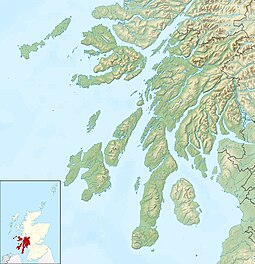Our website is made possible by displaying online advertisements to our visitors.
Please consider supporting us by disabling your ad blocker.
Lismore, Scotland
| Scottish Gaelic name | ⓘ |
|---|---|
| Meaning of name | great garden or great enclosure |
| Location | |
| OS grid reference | NM840408 |
| Coordinates | 56°31′N 5°30′W / 56.52°N 5.5°W |
| Physical geography | |
| Island group | Inner Hebridies |
| Area | 2,351 ha (5,810 acres) |
| Area rank | 33 [1] |
| Highest elevation | Barr Mòr, 127 m (417 ft) |
| Administration | |
| Council area | Argyll and Bute |
| Country | Scotland |
| Sovereign state | United Kingdom |
| Demographics | |
| Population | 192[2] |
| Population rank | 34 [1] |
| Population density | 8.2/km2 (21/sq mi)[2][3] |
| Largest settlement | Achnacroish |
| References | [3][4] |
Lismore (Scottish Gaelic: Lios Mòr, pronounced [ʎis̪ ˈmoːɾ] possibly meaning "great enclosure" or "garden") is an island of some 2,351 hectares (9.1 square miles) in the Inner Hebrides of Scotland. The climate is damp and mild, with over 166 centimetres (65 in) of rain recorded annually. This fertile, low-lying island was once a major centre of Celtic Christianity, with a 6th-century monastery associated with Saint Moluag, and later became the seat of the medieval Bishop of Argyll. There are numerous ruined structures, including a broch and two 13th-century castles.
During the 19th century, various new industries were introduced, including lime quarrying. During the early decades of the 20th century, the population exceeded 1,000, but this was followed by a lengthy decline. Although resident numbers are now less than 200, there was a small increase from 2001 to 2011. About a third of the population were recorded as Gaelic-speaking at the former date. The modern economy is largely based on farming, fishing and tourism, and the largest settlement is Achnacroish. Various shipwrecks have been recorded in the vicinity.
- ^ a b Area and population ranks: there are c. 300 islands over 20 ha in extent and 93 permanently inhabited islands were listed in the 2011 census.
- ^ a b National Records of Scotland (15 August 2013). "Appendix 2: Population and households on Scotland's Inhabited Islands" (PDF). Statistical Bulletin: 2011 Census: First Results on Population and Household Estimates for Scotland Release 1C (Part Two) (PDF) (Report). SG/2013/126. Retrieved 14 August 2020.
- ^ a b Haswell-Smith (2004) p. 109
- ^ Ordnance Survey. OS Maps Online (Map). 1:25,000. Leisure. Retrieved 21 August 2013.
Previous Page Next Page



